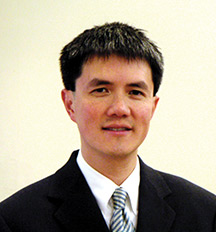INTERVIEW

“I stick to the simplest and the most basic strategies. I find that to be profitable. ”
Designing Your Own Trading Strategy
Quant And Consultant
Ernest P. Chan
If you’re a trader who wants to design your own strategies but would like some guidance, here’s someone who’s right up your alley. Ernest Chan is a quantitative trader and consultant who advises clients on how to implement automated
statistical trading strategies. He has worked as a quantitative researcher and trader in various investment banks including Morgan Stanley and Credit Suisse, as well as hedge funds such as Mapleridge Capital, Millennium Partners, and Mane Fund Management before striking out on his own. Chan, who earned a doctorate in physics from Cornell University, wrote a book, Quantitative Trading: How To Build Your Own Algorithmic Trading Business, available from John Wiley & Sons.
Stocks & Commodities Editor Jayanthi Gopalakrishnan(JG) and Staff Writer Bruce R. Faber (BF) interviewed Ernest Chan via telephone on May 6, 2009
Ernie, what led you to becoming an independent trader, considering your quantitative background?
Until 2006 I always worked for large institutions, investment banks like Morgan Stanley or Credit Suisse and hedge funds such as Millennium Partners or Maple Ridge Capital. I brought a history of sophisticated research in computer science and statistics to these firms. I thought that based on my academic knowledge I would be able to really bring a lot of profit to my employers. But that turned out not to be the case.
JG: Why?
Despite building complex models, I found that often the real-time results diverged from what the model or the backtest showed. So in 2006, partly based on my family relocation back to Canada and also because of a disillusionment with advanced computer science and statistical techniques, I decided to trade for myself. Instead of spending my employers’ money, I decided to use my own capital and adopt a different style in my trading to see if I could make a go of it.
JG: How was it different?
First of all, I did not have the excuse of having a manager interfere with my operation. If I lost money it was my fault and not because somebody else overrode my model. Second, I could try models that were not constrained by so-called risk management measures imposed by investment banks or hedge funds. I don’t believe they really reduce risk, but they are just used to satisfy senior management who have no idea what risk really is, as evidenced by the recent debacle with the banks.
So I started trading on my own. I opened a brokerage account and decided to do some backtesting and read up on everything I could. Of course I continued to read academic papers published by business school finance professors. I also read trading magazines such as Stocks & Commodities and blogs. I sucked up information from everywhere.
I tried to select the simplest strategies, because as an independent trader I could not afford to run the kind of strategy the big banks use. I do not have the sophisticated programs they have. I do not have the computational power they have, and I do not have the vast amount of historical data and real-time data and the superfast execution systems that institutional traders have. I stick to the simplest and the most basic strategies. I find that to be profitable. And that is how I started on the road to profitability. It has been quite a difference from my experience at the investment banks and funds.
JG: You brought up an interesting point, in that you select the simple strategy because you don’t have access to all the sophisticated equipment and data. So by trading at this reduced capacity, what are some strategies you can apply to gain an edge?
There are a lot of thinly traded stocks, so that is one area where big funds will not trade. Because of low liquidity, the big funds are unable to take advantage of them. They need to make money on a $10 million portfolio, and yet the stock may have a daily trading volume, in terms of dollars, maybe only $100,000. So there is no way this would interest the major institutional investor. But thinly traded stocks are something the independent trader can take advantage of.
Another area is low-priced stocks. I worked in numerous places where there is a strict prohibition against buying stocks less than $2, for example. There is no particular reason that rule was imposed except for possibly transaction costs. If you trade in a size suitable for an independent trader, however, there is no reason why you should not be able to buy these kinds of low-priced stocks.
There are also strategies that trade once a year, once a quarter, or once a month. These are strategies that do not interest a lot of hedge funds because they need to make a profit practically every month, if not every week. So if you have a strategy proven to be profitable once a year, you can be assured it is not something the institutions want to engage in. As an independent trader you have no such concern, so you can go right ahead with these strategies.